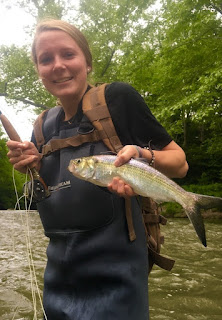The American shad’s Atlantic population remains at a historic low, despite longstanding commercial fishing bans in several states and millions of dollars invested in restoring the fish’s habitat.That sober news comes from the most comprehensive survey yet of the species’ status on the East Coast and the first of any kind in 13 years. The sprawling assessment by the Atlantic States Marine Fisheries Commission designates the shad population as “depleted” from Maine to Florida.
“There should be a lot more shad than there are out there,” said Michael Bailey, a U.S. Fish and Wildlife Service scientist and one of the assessment’s authors.
In the Chesapeake Bay region, the study suggests that the rate of death among adult shad — a key measure of a population’s health — is “unsustainable” in the Potomac River but “sustainable” in the Rappahannock and York.
Once one of the largest commercial fisheries along the coast and around the Bay, shad catches have bottomed out at about 1% of their late-1800s levels. Although the shad fishery has all but disappeared in the Chesapeake, scientists contend that the species serves a critical ecological role in the estuary as a vital link in its food chain.
But shad are an anadromous species, meaning they spawn in freshwater rivers but spend most of their adult lives in the ocean before returning to their native river to reproduce when they are 4 or 5 years old. Because shad rely on so many different habitats, they face a barrage of challenges through all stages of life.
The species’ continued struggles are mostly blamed on the amount of potential habitat blocked by dam construction, a loss of about 40% of its historic range. But shad also face threats from climate change, polluted water, deadly run-ins with hydroelectric turbine blades and getting eaten by larger fish.
The Marine Fisheries Commission, which regulates migratory fish in state waters along the Eastern seaboard, is grappling with whether more actions are needed to buoy the stock. The commission’s shad management board tasked a scientific panel Aug. 4 with recommending potential measures.
Fishery managers have been pulling regulatory levers for decades to help shad rebound but with little progress to show for it.
Commercial landings plummeted from about 50 million pounds at the beginning of the 1900s to 3.8 million coastwide by 1980. That year, Maryland imposed a moratorium on shad fishing. The Potomac River’s regulators followed suit in 1989; Virginia closed its rivers to shad fishing in 1994.
Ocean catches have been largely prohibited since 2005, but the new assessment finds no evidence that the action has breathed new life into the population.
While fishing was cut back, massive efforts were undertaken to boost the population. Pennsylvania, Virginia, Maryland and Delaware launched hatchery operations to rear shad for release in their rivers. Hundreds of millions of larval shad “fry” have been stocked in recent decades.
Meanwhile, major efforts were made to reopen historic spawning areas to fish returning from the sea each spring. Since the early 1990s, tens of millions of dollars have been spent opening more than 1,000 miles of Bay tributaries to migrating shad. Where possible, dams have been removed, but most of the reopening has been achieved through the construction of fish passages.
Research has shown that shad use those constructed passages at relatively low rates.
So, they seem to have tried all the ways they know how, and nothing is helping. Maybe the problem is in the streams? Curiously, some streams in Virginia are doing much better.
The Wombat has Rule 5 Sunday: Elizabeth Taylor ready for your digital enjoyment.



No comments:
Post a Comment